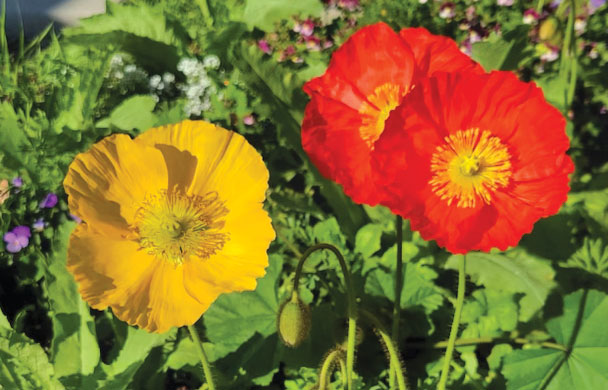If there really is no winter in Southern California, then which season are we in?
When you look carefully, dandelions are sprouting, daffodils are poking out of the ground and soon tiny buds will appear on the trees.
And the light! Don’t miss this chance to observe the late afternoon light, an hour before sunset. This light is known by photographers and painters as backlighting. If you make a point of looking at people, with the light behind them, you might see what looks like halo behind their head.
As the sun sets a few minutes later each day, we can feel the days getting longer, and spring is not far away.
WHAT TO PLANT NOW
This week I had the pleasure of touring the new arrival of the spring flower collection at Anderson’s La Costa Nursery and I learned a lot about poppies.
Considering how early spring arrives in Southern California, we are blessed with the perfect climate for California and Icelandic poppies. If we plan ahead and plant a variety of this colorful spring flower, we will have a small patch of yard, or a portion of our raised bed, glowing with pops of color over the next few months.
PLANT A PATCH OF PERFECT POPPIES
With the help of one of my favorite plantswomen, Hanna Faulstich from La Costa Nursery, we arrived at a plan for perfect border or small bed planting.
“If you plant the California poppies (the annual variety) at the back of the garden bed, then alternate with the Icelandic poppies closer to the middle,” she said. “You will have a full bed that will bloom for at least two months in the early spring, starting in late January. The California poppy has a flat-looking head, that lasts just a few days. Icelandic poppies have flower that is much larger, and long-lasting.
“To finish the bed, fill in with lower-growing annuals such as pansies, violas and lobelia. And in the front of the bed, add lots of alyssum. The white or purple varieties will spread and fill in all those empty spaces on the edges.”
This garden design plan will work at the entrance to your home on either side of the sidewalk, or in a large backyard bedding plant area. Be sure to purchase at least three large containers of each flower. The poppies are usually sold as 6-inch pots, or six-packs for pansies and lobelia. As you enlarge this garden plan, always multiply by three (six or nine pots of each) and the area covered could be 3 feet long up to 12 feet, with the depth covering at least 2-3 feet.
PANSIES ADD TO THE GARDEN BED
As all gardeners know, pansies are the star of the winter/spring garden. Seemingly unflappable, they survive wind, rain and near freezing temperatures, just to emerge the next day with new blossoms.
One of my first gardening jobs in Upstate New York, at a family-owned nursery, involved plant-sitting while the owners were on vacation. I arrived one cold spring morning at 8 a.m., with the temperature hovering at 39 degrees, to find the entire greenhouse filled with pansies that appeared to be frozen solid.
In a panic, I called one of the owners, and they replied, “Don’t worry, they will defrost by noon when the sun hits the roof of the greenhouse!” And sure enough, at 12 o’clock the frost turned into dew, and their little heads perked up perfectly.
ANNUALS FOR BORDERS
Lobelia — This brilliant blue annual provides some of the most vivid blues known to any gardener. These low, dense, trailing plants are covered with flowers throughout spring and summer and are ideal for edging or in containers.
Alyssum — Sweet alyssum flowers are so named for their lovely fragrance, and they will fill your bed from springtime through summer. They self-sow and will multiply for years. The white variety provides that pop of sparkle against the blue of the lobelia, and can be visible at night under a full moon or low garden lighting.
Violas and pansies — The only difficulty when buying violas and pansies is which variety to choose. Violas are smaller than pansies, but both come in seemingly endless varieties of color. Enjoy them in the cooler months, since they will die off in the heat of summer.
VISIT LOCAL GARDEN CENTERS
North County garden centers are brimming with flowers to fulfill your garden dreams, including Anderson’s La Costa Nursery at 400 La Costa Ave., Encinitas; Armstrong Garden Center at 5702 Paseo Del Norte, Carlsbad; Green Thumb Nursery, 1019 W San Marcos Blvd., San Marcos; Cordova Gardens, 902 Encinitas Blvd., Encinitas.
Jano Nightingale is a Master Gardener and horticulturist who teaches gardening at the Carlsbad Senior Center and other locations. Contact her at [email protected] for her upcoming schedule.



